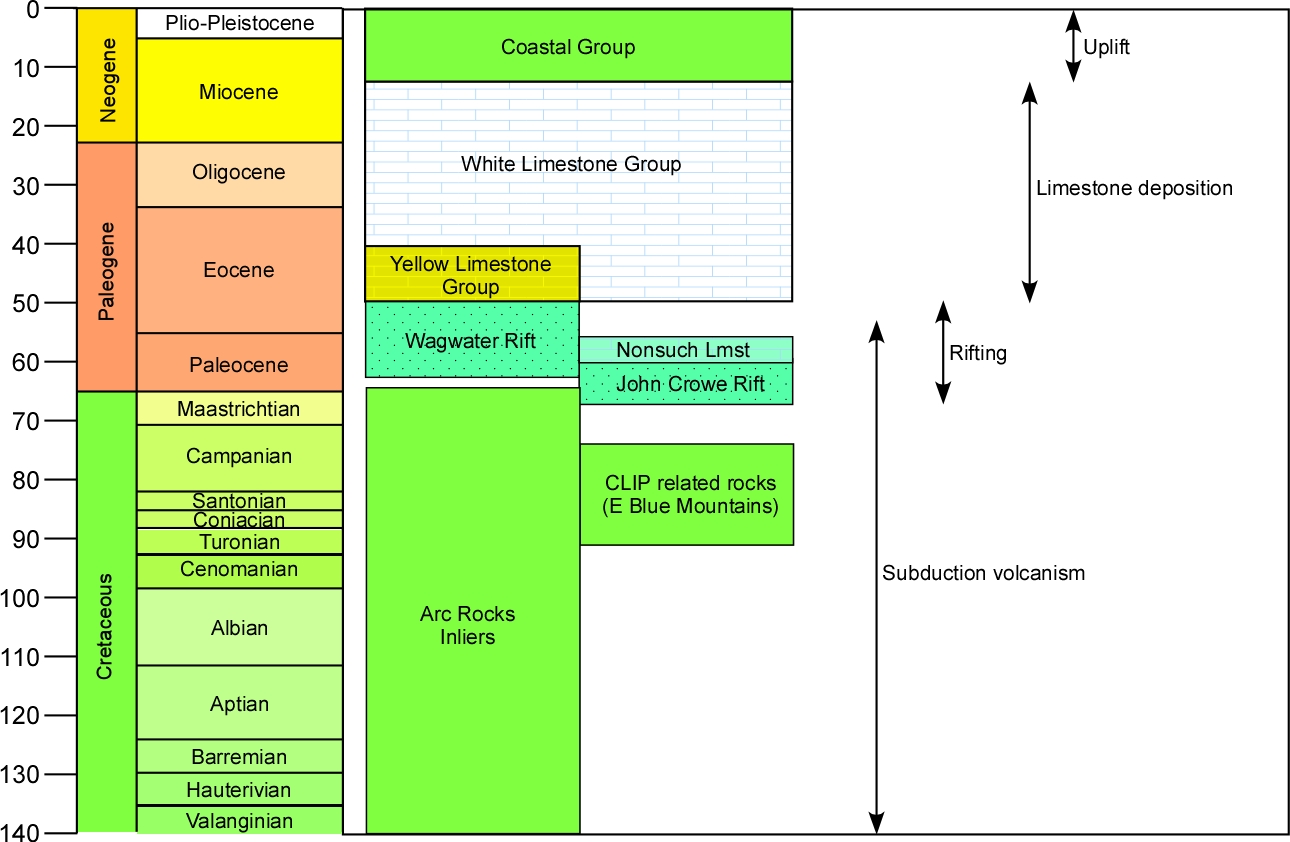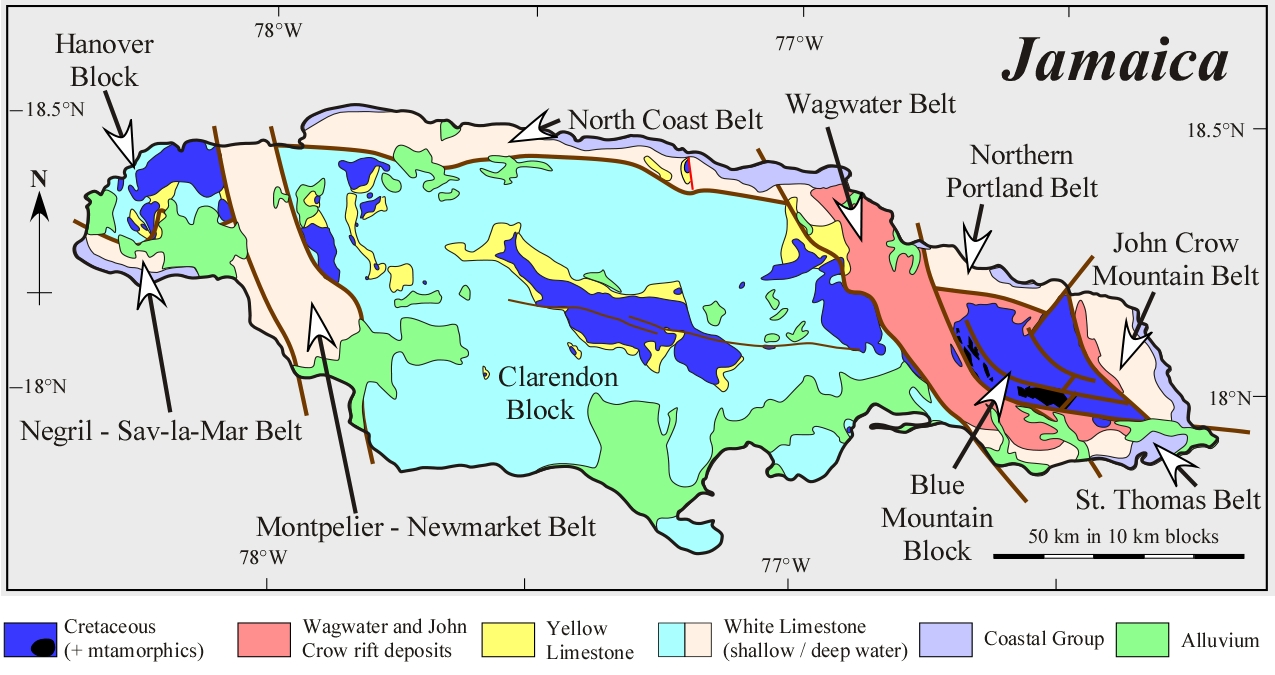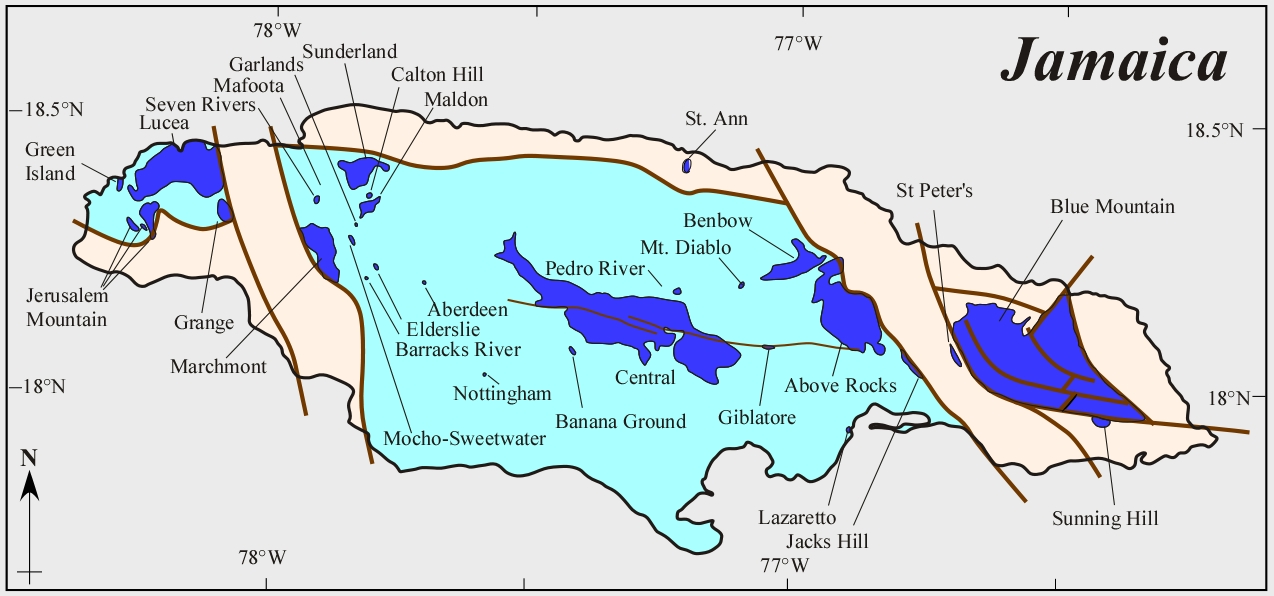Introduction
Jamaica is an island on the north-western part of the Caribbean Plate. It has had a long and varied geological history that directly relates to the evolution of the Caribbean Plate and the North American and South American plates. Despite this, the geology of Jamaica is still only partially worked out and new finds are being made all the time. This site highlights some of the interesting features of the geology of Jamaica.
The rocks occuring in Jamaica span the last 140 million years. Figure 1 shows a simplified geological column for the rocks found in Jamaica together with the stage names (smaller segments of geological time) and the ages in millions of years (Ma).

Figure 1. Simplified geological timescale for Jamaica showing main rock types and main processes (Quaternary and Holocene not show for scale puroposes). Vertical scale in millions of years (Ma).
The Geology of Jamaica
The larger part (about two-thirds) of the island of Jamaica exposes rocks belonging to the White Limestone Group (Figure 2). These rocks form the typical karst plateau landscape of the island and also host the bauxite deposits. The White Limestone consists of pure carbonates (limestones and dolostones) and overlies the rocks of the Yellow Limestone Group. The Yellow Limestone Group consists of pure limestone, impure limestones and a range of clastic rocks (mudstones, shales, sandstones and conglomerates). The White Limestone is separted from the Yellow Limestone by an unconformity.

Figure 2. Simplified map showing the geology of Jamaica and the blocks and belts.
Rift Basins
Eroisonal (or fault bounded) windows expose the older rocks of Jamaica. In the east of the island are two belts containing predominatly clastic rocks: the John Crow Mountain Belt, and the Wagwater Belt. The John Crow Mountain Belt ciontains a clastic sequence of conglomerates and mudstones (Bowden Pen and Moore Town formations). The Wagwater Belt contains two thick clastic units, a lower series of conglomerates called the Wagwater Formation, and an upper series of rocks called the Richmond Formation. Three suites of volcanic rocks are intercalated with the clastics; the basaltic Halberstadt Volcanics and the acidic Newcastle volcanics are intercalated (mostly) within the Wagwater Formation, whereas the Nutfield Volcanics are found within the Richmond Formation.
Cretaceous Inliers
The older rocks are exposed in a series of inliers (older rocks surrounded by younger rocks) and are generally referred to as the 'Cretaceous inliers' (although they may also contain rocks of Paleocene age). These are shown in Figure 3. The larger ones are the Blue Mountains Inlier, the Central Inlier, the Lucea Inlier, the Above Rocks Inlier and the Benbow Inlier. Jamaica has an excellent succession of Cretaceous rocks representing most stages and containing a wealth of fossils.

Figure 3. The Cretaceous Inliers of Jamaica.
White Limestone Blocks and Belts in Jamaica
Various blocks and belts (Figure 2) have been recognised in Jamaica and are mainly based on the different rocks that comprise the White Limestone Group. The blocks are composed of shallow-water White Limestone rocks and the belts by deep-water White Limestone rocks; the different rocks can be identified based on the fossils that they contain. The shallow-water White Limestone contains abundant larger benthic foraminifers together with corals, algae and molluscs, which lived within the photic zone. The deep-water White Limestone contains planktic foraminifers and radiolarians. Smaller benthic foraminifers, ostracods and fish teeth demonstrate that the deep-water White Limestone was deposited in water depths of 2,000 m or more.
Coastal Group
Some 12 to 14 million years ago, the uplift of Jamaica began. This uplift saw the formation of the elevated limestone plateaux and the fault-bounded Cretaceous inliers. Around the edge of the island a series of mixed clastic (conglomerates and sandstones) and carbonate (limestones and marlstones) rocks accumulated. These rocks are know as the Coastal Group and contain a wealth of fossils.
Volcanic ash settled on the newly risen plateau limestones sourced from major volcanic eruptions in Central America. This ash was converted to bauxite by extensive leaching in the alkaline environments of the karst landscape of Jamaica.
Differential uplift also created interior valleys (such as, St Thomas-in-the-Vale). Alluvial deposits (red clays and conglomerates) were deposited in these valleys from erosion in the Cretaceous inliers and also from the redistribution of the bauxite deposits. Thick sequences of sandstones and conglomerates were also deposited along the coatal zone and now form extensive coastal plains where cities have developed and vast sugar estates have built up.
Faults
Jamaica is a seismically active island. The Earthquake Unit records between 80 and 120 earthquakes each year. As such there are numerous faults in Jamaica. Part of my current research is mapping out these faults.
References
This site provides references to additional information usually in scientific papers. While some of these are free online, others are not. For papers that are not free, you can ask for copies through Research Gate if the author has a page there (see the link below).
I provide a link here to a short paper that I prepared for a newspaper, that was not published. It provides an over-view of the origin of the different parts of Jamaica. Click to download: Mitchell, S. F. 2022. Out of Many One